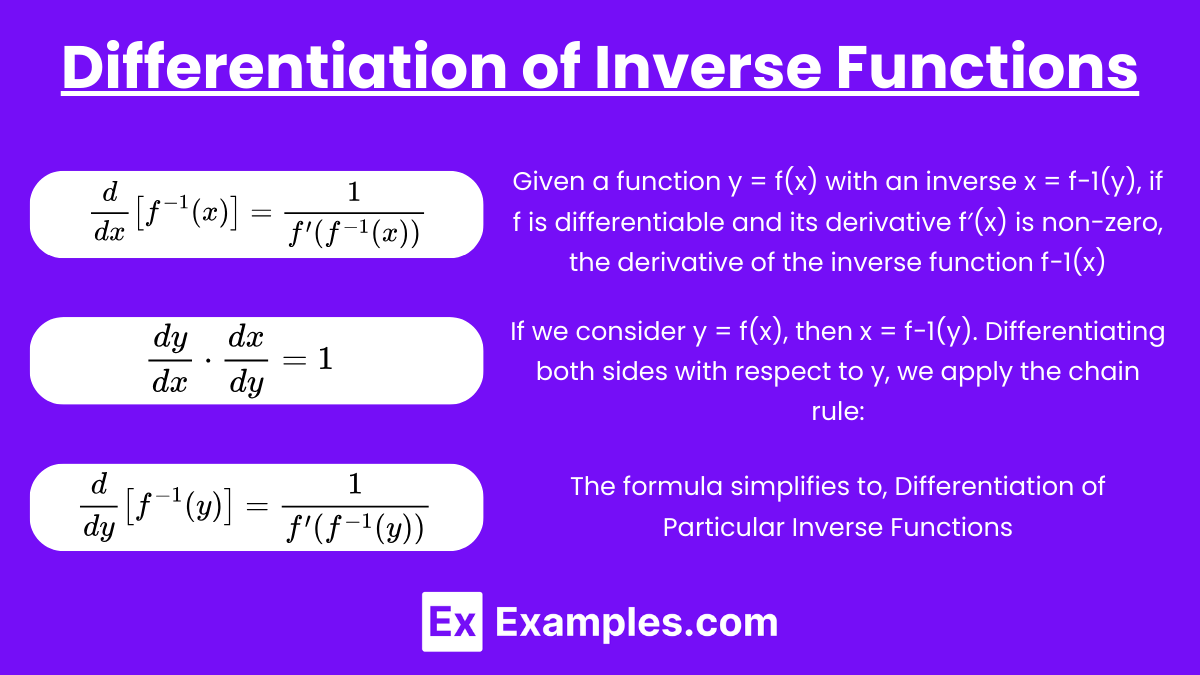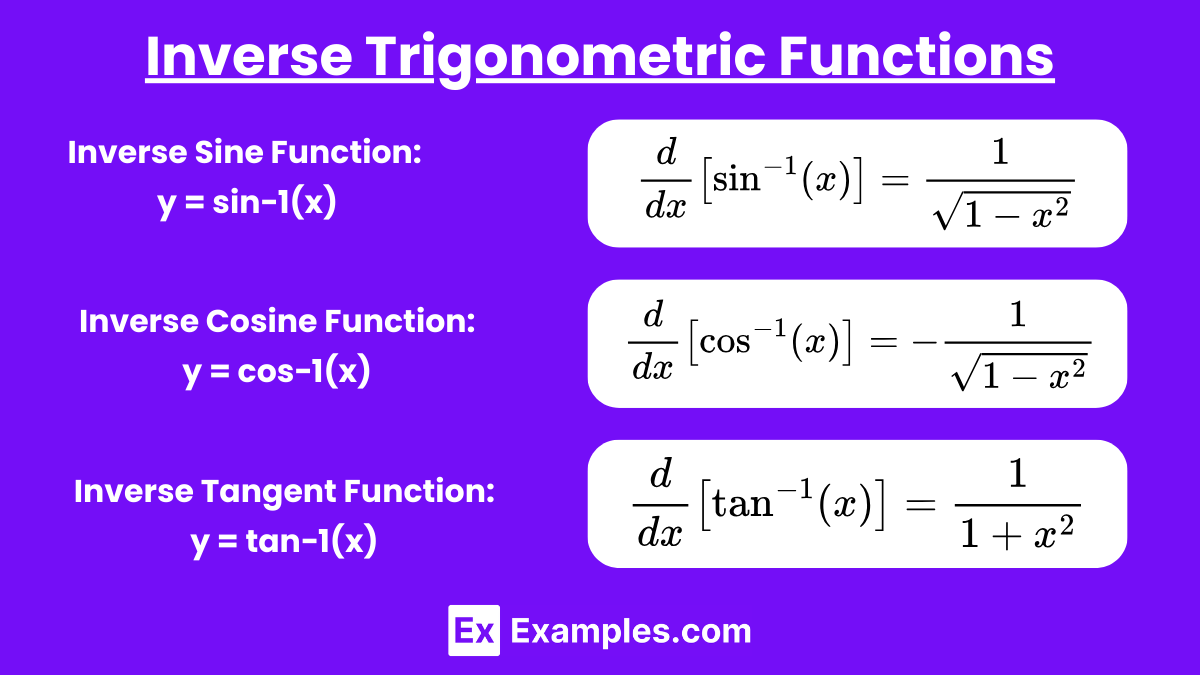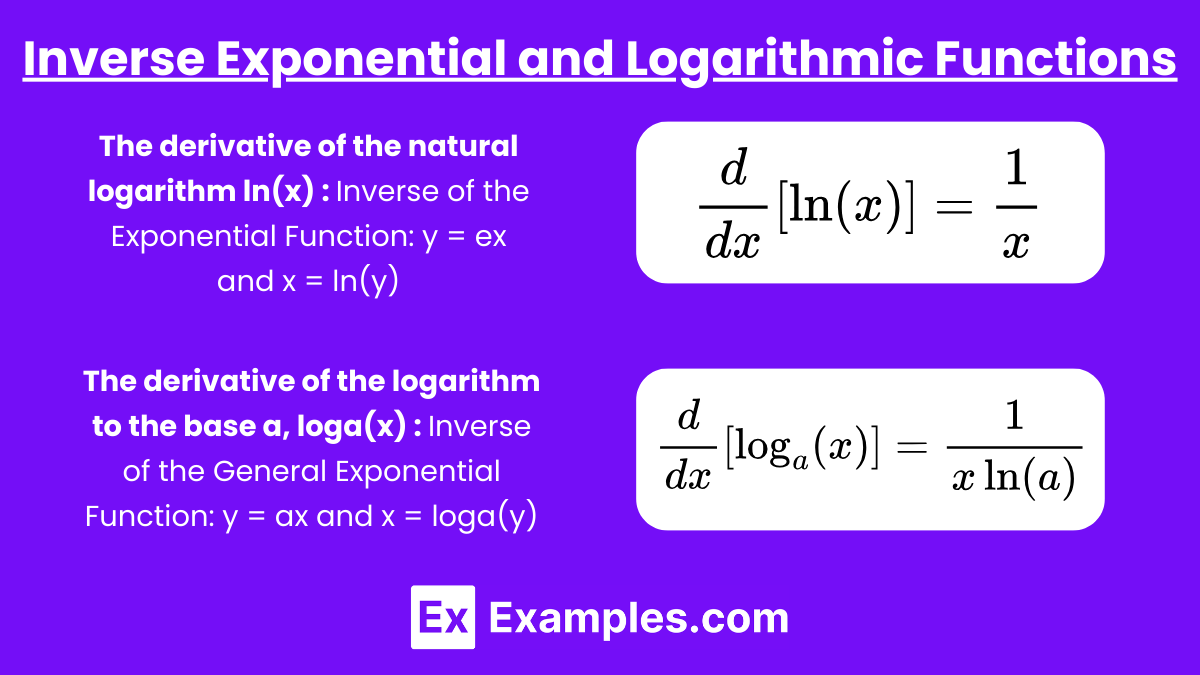Differentiation of inverse functions is a critical concept in calculus, particularly in the study of how functions behave when reversed. This involves finding the derivative of a function’s inverse, which plays a significant role in various applications like solving equations, analyzing graphs, and understanding rates of change. For both general and specific functions, knowing how to differentiate their inverses is essential for success in AP Calculus AB and BC, as it builds a foundation for more complex topics like integrals and series.
Learning Objectives
When studying the Differentiation of General and Particular Inverse Functions for the AP Calculus exam, you should aim to understand how to derive and apply the formula for the derivative of an inverse function. Focus on memorizing key derivatives of inverse trigonometric functions, mastering implicit differentiation techniques, and recognizing the conditions under which these formulas apply. Additionally, practice solving problems involving the differentiation of inverse functions, as these are commonly tested in both AP Calculus AB and BC exams.
General Concept of Inverse Functions

An inverse function essentially reverses the operation of a function. If f(x) is a function, its inverse f−1(x) satisfies the condition:
For a function to have an inverse, it must be bijective, meaning it is both one-to-one (injective) and onto (surjective). A one-to-one function ensures that each output corresponds to exactly one input, which is crucial for the existence of an inverse function.
Differentiation of Inverse Functions

Given a function y = f(x) with an inverse x = f−1(y), if f is differentiable and its derivative f′(x) is non-zero, the derivative of the inverse function f−1(x) at a point can be found using the following formula:
This formula is derived from the chain rule. If we consider y = f(x), then x = f−1(y). Differentiating both sides with respect to y, we apply the chain rule:
Given that , the formula simplifies to:
, Differentiation of Particular Inverse Functions
Let’s explore the differentiation process for some specific inverse functions commonly encountered in AP Calculus.
1. Inverse Trigonometric Functions

a. Inverse Sine Function: y = sin−1(x)
For y = sin−1(x), the derivative is:
b. Inverse Cosine Function: y = cos−1(x)
For y = cos−1(x), the derivative is:
c. Inverse Tangent Function: y = tan−1(x)
For y = tan−1(x), the derivative is:
2. Inverse Exponential and Logarithmic Functions

a. Inverse of the Exponential Function: y = ex and x = ln(y)
The derivative of the natural logarithm ln(x) is:
b. Inverse of the General Exponential Function: y = ax and x = loga(y)
The derivative of the logarithm to the base a, loga(x), is:
Differentiation of Inverse Functions: AP Calculus AB vs. AP Calculus BC
Both AP Calculus AB and AP Calculus BC cover the differentiation of inverse functions, but the topics and complexity of questions differ between the two exams. Here’s a breakdown:
AP Calculus AB
- Focus on Basic Inverse Functions:
- Differentiating the inverse functions of sin(x), cos(x), and tan(x).
- Working with the inverse of exponential functions like ex and their corresponding logarithms, particularly ln(x).
- Understanding the geometric interpretation of the derivative of an inverse function, especially in the context of reflecting functions across the line y=x.
- Key Derivatives: Memorizing derivatives such as
,
- Chain Rule Application: Problems often involve applying the Chain Rule to composite functions where one of the components is an inverse function.
- Graphical and Analytical Problems: Identifying inverse functions graphically and analytically, including finding slopes of tangent lines to inverse functions.
AP Calculus BC
- Extended Range of Inverse Functions:
- Beyond basic trigonometric and logarithmic functions, BC may include inverse hyperbolic functions like sinh−1(x), cosh−1(x), and tanh−1(x).
- Problems may also involve inverse functions of more complex algebraic functions.
- Parametric Equations: Differentiating inverse functions within parametric equations, where you need to find derivatives using
and apply the inverse differentiation rules.
- Advanced Trigonometric Identities: Using advanced trigonometric identities in the differentiation process, especially when working with compositions of inverse trigonometric functions and other trigonometric functions.
- Implicit Differentiation: BC often includes problems that require implicit differentiation where the inverse function is embedded within an equation.
- Differential Equations: Applying differentiation of inverse functions within the context of solving differential equations, particularly where the inverse function plays a role in the solution method.
- Taylor Series and Approximations: Using Taylor series to approximate inverse functions and differentiating these approximations.
- Integration of Inverse Functions: Problems might also involve integrating the derivatives of inverse functions, connecting differentiation and integration concepts.
Examples
Example 1: Differentiating the Inverse Sine Function
Consider the function y=sin−1(x). To find the derivative, we use the formula for the derivative of an inverse function. Since , the differentiation process gives us . This result is particularly useful when solving problems that involve inverse trigonometric functions, such as calculating angles or solving trigonometric equations in calculus.
Example 2 : Differentiating the Inverse Tangent Function
Let’s differentiate y=tan−1(x). Using the inverse function derivative formula, we find that . This derivative is important in various calculus problems, especially those involving rates of change and optimization where the tangent function plays a role. It also appears in integrals and when analyzing curves.
Example 3: Differentiating the Natural Logarithm Function
For the natural logarithm function y=ln(x), we recognize that it is the inverse of the exponential function y=ex. The derivative of ln(x) is found using . This result is fundamental in calculus, especially when dealing with exponential growth and decay, solving differential equations, and evaluating limits.
Example 4: Differentiating the Inverse Cosine Function
Consider the function y=cos−1(x). To differentiate it, we apply the inverse function derivative rule, yielding . This derivative is useful in trigonometric applications and in problems involving angle calculations where the cosine function is inverted.
Example 5: Differentiating the Inverse Hyperbolic Sine Function
For the inverse hyperbolic sine function y=sinh−1(x), the derivative can be derived similarly to inverse trigonometric functions. The formula gives us . This result is often used in more advanced calculus problems, particularly those involving hyperbolic functions, which appear in areas like engineering and physics.
Multiple Choice Questions
Question 1
Given that f(x) = sin(x) and its inverse f−1(y) = arcsin(y), what is the derivative ?
A)
B)
C)
D)
Correct Answer: A)
Explanation: For an inverse function f−1(y), the derivative is given by:
For f(x)=sin(x), the derivative is f′(x)=cos(x). Therefore, the derivative of the inverse function
So, the correct answer is A.
Question 2
If f(x)=ln(x) and its inverse f−1(y)=ey, what is the derivative ?
A) ey
B)
C)
D) yey−1
Correct Answer: A) ey
Explanation:
For the inverse function f−1(y)=ey, the derivative is found directly since . This is because the derivative of the exponential function ey with respect to y is itself:
Thus, the correct answer is A.
Question 3
If f(x)=x1 and its inverse f−1(y)=y1, what is the derivative ?
A) −1 / y2
B) 1 / y2
C) 1 / y
D) −1 / y
Correct Answer: A) −1 / y2
Explanation: For the inverse function f−1(y)=1/y, the derivative is:
This is because the power rule gives us , which is equivalent to −1/y2. Therefore, the correct answer is A.


